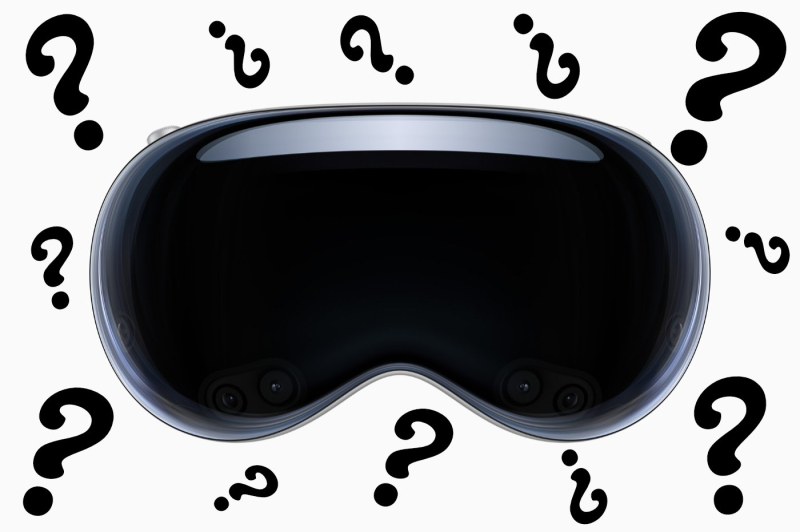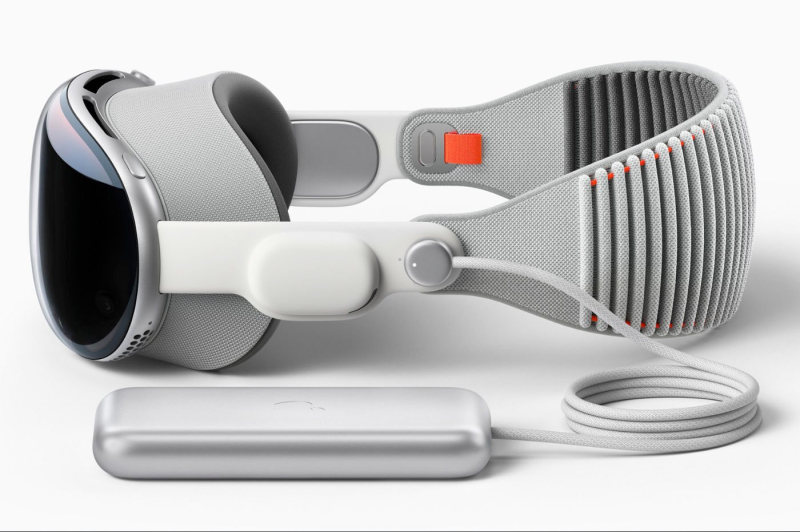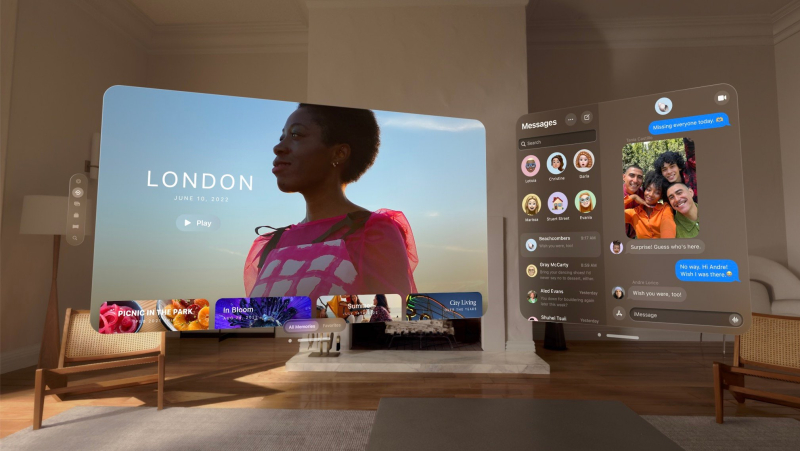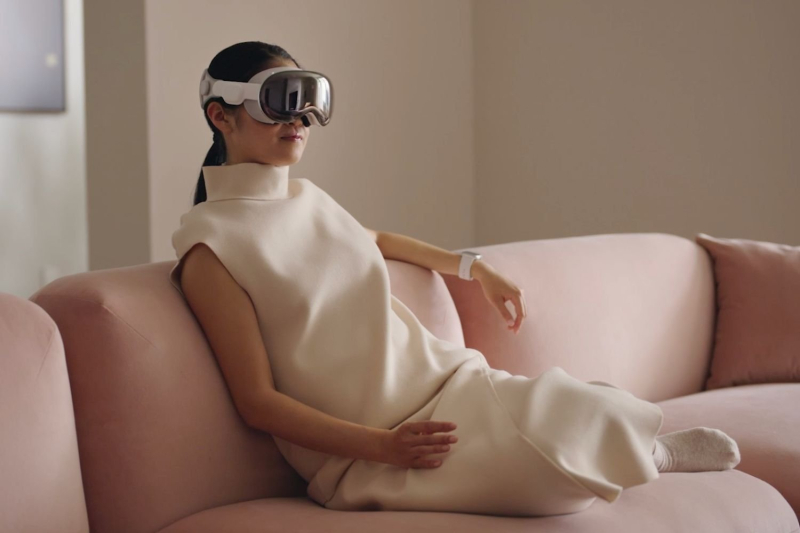
© Apple/Lemon squeezer
We haven't seen this since the first iPhone. On February 2, 2024, in New York, the queue in front of the Apple Store on 5th Avenue reminded us, to a lesser extent, of Apple's prosperous years. If Tim Cook and his lieutenants were present, the real star of the day was the Vision Pro.
The Pommé mixed reality headset opens a new category of products, several years after the Apple Watch. A bold and risky bet for the company which preferred to bet on a ten-year-old technology, which has failed to convince the general public, even if it means falling behind in the development of artificial intelligence, the new chicken. golden eggs of Big Tech.
Since the release of the Vision Pro, images, each more ridiculous than the last, have been popping up on the web, just to create buzz around the product. If early adopters push the limits of their imagination to boost their social media stats, the Vision Pro is a product to take seriously.
For more than 10 years, part of the Tech industry has sought to democratize virtual reality, without success. As is often the case in its history, Apple therefore does not invent anything, but makes an already existing technology accessible and cool. However, I dare to hope that Apple was wrong with the Vision Pro.
Unboxing #Apple #VisionPro : on découvre TOUT le contenu de la boîte ! 🤩 #01news pic.twitter.com/kgCPaDA8Dj
— 01net (@01net) February 2, 2024

© Apple
I could argue that the problem with the Vision Pro lies in its technical limitations. Although Apple offers the most advanced virtual/augmented/mixed reality technology (in the opinion of early testers), it is still far from ideal to meet the expectations of the general public.
The Vision Pro is heavy (you can imagine carrying an iPad on the front of your head for hours for ?) and its battery life is very limited (no more than 3 hours). A cable hangs along your arm to connect the headset to a battery placed in your pocket, some users have noted display bugs (the focus is not always in the foreground), eye tracking or gesture recognition. Faults that not everyone has noticed but which exist.
If these inconveniences can disappoint (especially for a device sold for 4,000 dollars), that is not the problem. Simple updates can correct some of these defects.
Furthermore, there is no doubt that the technical limits of this first generation will be exceeded thanks to technological advances, in particular the miniaturization of several components. Looking ahead in the longer term, we can also imagine that the helmet will become glasses.
It is therefore appropriate to perceive the Vision Pro as an alpha version of a product intended to better respond, in the more or less near future, to the constraints of everyday life. But that's not the problem.

© Apple
In use, the Vision Pro is also the most advanced virtual/mixed reality headset on the market. The first testers are unanimous on this point. It can, its selling price being seven times higher than Meta's Quest 3, the most advanced model to date.
Despite everything, the Vision Pro does not escape questions about its daily usefulness. The media The Verge raises a whole bunch of questions at the conclusion of his test.
Subscribe to Lemon Squeezer
There is no doubt that the entertainment experience promises an immersion never before seen. Imagine putting on the headset and watching a movie all around you or immersing yourself in the middle of the Grand Canyon from your couch or a park bench. Not necessarily useful but definitely fun.
Vision Pro admirers also promise a future where workspaces are virtual, with giant screens all around us. The Apple headset already allows you to use a keyboard and mouse, and to move the Mac screen into augmented reality, thus promising a new era of work.
Those are promises. Concretely, a lot of applications that we use every day are not available (Youtube and Netflix are only accessible on Safari for example, with a lot of limitations). Some applications are currently only at an early stage. I am thinking, for example, of Plans which appears in a still floating window whereas a virtual marking on the ground or in a head-up view would make much more sense. I'm also thinking about gaming, which is still too limited on the Vision Pro. And porn, simply inaccessible on the headset.
Despite these questions, uses are not the real problem with the Vision Pro.With time and Apple's entry into this sector, developers will become more interested in VR, as will video game publishers. For example, Microsoft has already announced the Office 365 suite for Vision Pro. Google will finally develop an exclusive application for the headset. And the others will follow, there is no doubt.

The real problem with the Vision Pro is not the Vision Pro. In a capitalist society, Apple has every incentive to look for ways to continue growing. However, the smartphone market has reached a level of maturity that does not allow it to maintain this growth. The iPhone accounts for more than half of the company's revenue. Then come the services (around 20-25%) which only make sense if you have an iPhone (or another Apple product). All other products of the brand only represent 25-30% of its results. And some must be related… to an iPhone.
Despite the quality of its services and software, Apple has always been a hardware specialist. To maintain an upward growth curve (and satisfy shareholders), the company must therefore materialize its plan for the decades to come. Because Apple is also a company whose wealth is based on its stock market listing, whose eyes are fixed on the future. What else besides a VR headset can give a glimpse of this future ?
Let me summarize: Apple is launching a new range of products in an industry that is struggling to convince. The price is not a barrier for Apple fans, the company can afford to use all the most advanced technologies of the moment. And to market a not quite finished V1 at a high price. But it’s Apple, it’s ok!
From a strategic point of view, the company would be wrong to be embarrassed. Its survival depends on it, especially since it has fallen far behind artificial intelligence. The problem is therefore neither Apple nor its Vision Pro.
The real problem with the Vision Pro is you. It's me. This is us. Do we want a world where each individual puts on a helmet (or glasses, let's be crazy!) that propels them into another world with one click? ;? Do we want a world where we come across individuals watching a YouTube video while walking in the street (even if that is not the goal) ? Do we want of a world where interactions between individuals are even more limited ?
Defenders of the technology will say that the headset is not made for this, that we only use it occasionally, for very specific uses. In my opinion, this vision is very utopian and forgets the incapacity of human beings to adopt new technologies sparingly (I will come back to this).
Are our brains capable of managing 4 or 6 windows broadcasting different content while working? I am incapable of writing this article while watching a Youtube video, my feed X and my Instagram account. I don't even want to divide my attention that much, preferring to concentrate on one task.
What about entertainment? The VR headset is a product of individualists. Watching a movie in such a device is certainly a great experience…alone. I like watching my series and films with my wife or my family, following a sporting event with my friends, following a debate and chatting with my loved ones at the same time.

© Apple
The problem with the Vision Pro is more of a societal, even philosophical, order. Human beings have demonstrated with smartphones and tablets that he was not able to master its use. A study just released has just revealed that screens were partly responsible for the decline in sexuality, even more so among the youngest who, more 50% prefer to reject their partner's advances to watch a Netflix series.
Studies on smartphone addiction have demonstrated changes in social behavior. For example, the simple sight of a smartphone on a table during an exchange already creates frustration in the interlocutor who thinks they are not interesting enough. At least less than any call or notification that might occur during the conversation.
I won't dwell on the growing loneliness, the possibility of having a meal delivered to your home from your phone rather than going to a restaurant, watching Netflix rather than going to the cinema and so many other societal phenomena generated by the advent of the smartphone and the proliferation of screens. While they were supposed to open us up to the world and our fellow human beings, screens have, for many human beings, had the opposite effect, reinforcing the feeling of loneliness and loneliness. 8217;insulation.
Many compare the Vison Pro to the first iPhone, criticized by its detractors in its early days and then becoming a standard. In my opinion, the comparison is hazardous for multiple reasons, the main one being the following: the helmet or goggles create a physical barrier that is both visible and invisible between human beings.
Experience has shown us that we are not capable of controlling our addictions to new technologies. As proof, today there are movements of disconnection almost everywhere, an awareness in certain circles of the toxic side of this over-connectivity and even therapies to get out of this addiction.
When I see the slowness at which this awareness has come about, when I imagine the consequences of such technology on the psychology of the human being (c’ #8217;is ironic for a brand like Apple which claims to be sensitive to the mental health of users) I tell myself that a future populated by helmeted individuals is more worrying than fascinating. And that perhaps it is time to put an end to this frenzy of infinite technological progress at the expense of our well-being. But that's just my opinion.
📍 To not miss any news from Presse-citron, follow us on Google News and WhatsApp.

